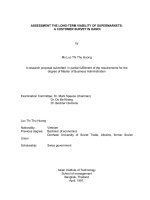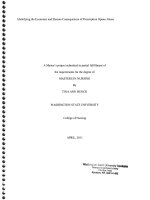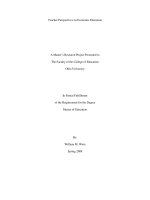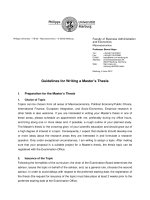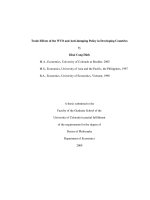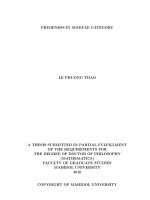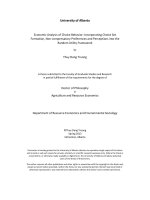A MASTER''''S PROJECT SUBMITTED IN PARTIAL FULFILLMENT OF THE REQUIREMENTS FOR THE DEGREE OF MASTERS IN NURSING potx
Bạn đang xem bản rút gọn của tài liệu. Xem và tải ngay bản đầy đủ của tài liệu tại đây (630.78 KB, 20 trang )
Identifying the Economic and Human Consequences
of
Prescription Opiate Abuse
A Master's project submitted in partial fulfillment
of
the requirements for the degree
of
MASTERS IN NURSING
By
TINA ANN BUNCH
WASHINGTON STATE UNIVERSITY
College
of
Nursing
APRIL,2011
Washinfl(On
S~ete
University Spokane
Rlverpolnl
Campus
Ubrary
P.O.
Box 1495
Spokane,
WA
99210-1495
To the Faculty
of
Washington State University:
The members
of
the Committee appointed to examine the master's project
of
TINA ANN
BUNCH find it satisfactory and recommend that it be accepted.
Mel Haberman, Ph.D.
, ARNP, FNP
11
•
Identifying the Economic and Human Consequences
of
Prescription Opiate Abuse
ABSTRACT
By Tina Ann Bunch, BSN, RN
Washington State University
April, 2011
Chair: Mel Haberman
Prescription drug abuse is our nation's fastest growing health care concern. The non-
medical use
of
prescription pain relievers is now the second most prevalent form
of
illicit drug
use in America "and it's tragic consequences are seen in substance abuse treatment centers and
hospital emergency departments throughout our nation" (Goodale, 2010,
pI).
Nearly
1.2
million
of
emergency room visits were due to prescription drug use in 2009, an increase
of98.4%
from
627,291 visits in 2004 to 1,244,679 in 2009 (DAWN, 2010). This dramatic escalation
of
prescription drug use has placed a significant impact on the global consumption
of
all opioids,
the United States
(US.)
consuming 80%
of
the global supply and 99%
of
the global supply
of
hydrocodone (Manchikanti, 2007). Unfortunately, the rising prescription abuse has lead
to
a
national health care crisis, impacting many areas
of
our society both financially and emotionally.
This paper reviews the current relationship between health care costs and prescription
opiate abuse. In addition, the paper examines the devastating consequences that opiate abuse has
on the individual abuser and their family members, as well as the benefits
of
attending treatment
programs specifically designed to address prescription opiate abuse. In order
to
decrease the use
of
prescription opiates, further research is needed
to
determine whether or not educational
111
•
methods for prescribers and persons with opiate addiction will alleviate the prescription drug
concern.
Key Words: opiate abuse, pain management, chronic pain management, overcrowded
emergency departments, increased healthcare costs, consequences
of
prescription opiate abuse,
prescription opiates, treatment programs
iv
TABLE OF CONTENTS
ABSTRACT iii
INTRODUCTION 1
Theoretical Framework 3
Social Construction Theory
.3
REVIEW
OF
LITERATURE 4
Health Care Costs 4
Individual Consequences
of
Prescription Opiate Abuse 7
Family Consequences
of
Prescription Opiate Abuse 7
Benefits
of
Treatment to Reduce Hea1thcare Costs 9
IMPLICATIONS FOR
NURSE
PRACTITIONERS 10
SUMMARY
11
References
13
v
INTRODUCTION
Opioids are a class
of
drugs that include both natural and synthetic substances. The
natural opioids include opium and its chemical derivative, morphine. Heroin, the most frequently
abused opioid, is made from opium as are a variety
of
other synthetic opoids medications that are
commonly prescribed for the treatment
of
pain. The classification
of
synthetic drugs that mimic
the pharmacologic action
of
opium and its derivatives includes codeine, oxycodone (OxyContin),
meperidine (Demerol), fentanyl (Sublimaze), hydromorphone (Dilaudid, and methadone
(Opioids
& Related Disorders, 2009).
Opioids act directly on the central nervous system
of
the brain, resulting in feelings
of
euphoria. These feelings and the physical and psychoactive affects
of
the drugs can help explain
the non-medical use (misuse) and abuse
of
prescription opiates, a serious and rapidly growing
health care concern. According to the National Survey
on
Drug Use and Health (2008),
approximately 52 million Americans ages
12
and older reported using opioids, also known as
opiates, for non-medical use at some point in their life and 6.2 million currently use them. Abuse
of
the prescription opioids has been defined as:
Any intentional use
of
a medication with intoxicating properties outside
of
a
physician's prescription for a bona fide medical condition, excluding accidental
misuse. This definition
of
abuse includes use
of
medications prescribed for
another user, even
if
for a physical condition, because this behavior can be risky
(Comptom
& Volkow, 2006.
p.
4).
Opiate abuse imposes an enormous financial strain on health care in the U.S. and criminal
justice systems. Billions
of
dollars are spent on health care costs, criminal justice costs, law
violations, and loss
of
productivity due to incarceration (Birnbaum et aI, 2006). Emergency room
visits have soared, resulting from misuse and abuse
of
prescription opiate drugs (SAMHSA,
2010). The highest numbers
of
emergency room visits were related
to
the request for prescription
of
oxycodone, hydrocodone, and methadone; prescriptions written for all
of
these have risen over
the last 5 years (CDC, 2010). In addition, Americans are consuming 80%
of
the global supply
of
all opioids and 99%
of
the global supply
of
hydrocodone (Manchikanti, 2007).
In addition to the economic costs associated with this problem, opioid abuse is
detrimental to many aspects
of
social life in the United States (U.S.). For example, it disrupts
family member's lives, impacts divorce rates, contributes to single parent families, and increases
child abuse and neglect (CASA, 2005). Other consequences
of
opiate abuse include academic
underachievement, unemployment, decreased productivity, missed days at work, and high school
drop-out rates (Galanter
& Kleber, 2008).
In an effort to address the health care crisis brought about, chemical dependency
programs have been designed specifically for individuals abusing prescription pain relievers.
These treatment programs have proven to be effective in reducing health care costs, arrests, risks
ofre-arrest and felony convictions. Yet, despite this effort, the war against prescription opiate
abuse continues
to
soar. As the epidemic
of
prescriptions for opiates increases, so do the efforts
to develop specific educational strategies for primary care providers on pain management,
prescription drug use and abuse.
The purpose
of
this paper is to explore the correlation between prescription opiate abuse
and the rise in health care costs, and
to
consider the devastating consequences
of
opiate abuse on
the individual abuser and their family members. In addition, the paper examines the benefits
of
2
treatment to reduce healthcare costs and addresses recommendations for further research and the
clinical practice
of
nurse practitioners.
Theoretical Framework
There is one theory that helps explain why prescription opiate abuse has placed a huge
financial strain on our health care system and imposed devastating consequences
to
individuals
and families. The Social Construction Theory was selected as a framework for understanding
these complex issues.
Social Construction Theory
Social Construction Theory states that social constructs are the by-product
of
human
choice rather than from nature (Boghossian, 2006). A social construct is a social interaction
amongst individuals based on their values and patterns
of
behavior. The misuse
of
opioids can be
viewed as a social construct given that humans, including prescribers, patients, and social groups
(such as families) consciously make choices to disregard the appropriate use
of
prescription
opiates. Prescribers show evidence
of
this when they prescribe opiates before obtaining a
throughout medical history regarding the patients' complaints
of
pain. Patients who misuse
prescription medications, whether their own or someone else's, show disregard for the
appropriate use
of
prescription opioids when they overutlize the emergency departments for non-
urgent medical concerns. Social groups and families make choices that influence individuals to
misuse prescription opioids when they allow their family members to use their prescription
opiates.
These human choices lead to a series
of
negative repercussions that not only affect the
individual but that also have a wide range
of
negative consequences for individuals and to our
society. In turn, these negative consequences have a huge rippling effect on health care costs, as
3
well as devastating consequences
to
the individual user and their family members. These social
constructs about prescription opiate abuse are generated from relationships between the
prescriber, abuser, society and the family.
REVIEW
OF
LITERATURE
An extensive literature review was performed using electronic databases including,
PubMed, Medline, CINAHL, Google Scholar and the document entitled, National Drug Control
Policy
& Prescription Drug Abuse (2008). The key terms used in the searches were opiate abuse,
pain management, chronic pain management, increased healthcare costs, emergency department
visits, opiate consequences, and treatment programs. From the thousands
of
articles that were
identified using this search process, 48 articles were selected for review. The abstracts
of
these
were reviewed for pertinence to the topics and
21
full text articles were retrieved and read in
detail. In addition, four articles were retrieved that specifically pertained to the inappropriate use
of
emergency room visits for narcotic administration or prescription use.
Of
the
21
articles that
were read in depth,
14
addressed health care costs, three addressed individual consequences
of
opiate abuse, two addressed how opiate abuse affects family members and two addressed
treatment programs.
Health
Care
Costs
According to Manchikanti (2007), from 2004-2007 the number
of
emergency department
(ED) visits that were directly related to opioid abuse in the U.S. increased from 198,000 to
420,000. Among the central nervous systems agents methadone, oxycodone, and hydrocodone
were the most frequent opioids prescribed; hydrocodone/combinations in 51,225 ED visits;
oxycodone/combination in 42,810 ED visits; and Methadone in 41,216 ED visits (2007). Parallel
to opiate and non-medical prescription drug use, Americans consume 80%
of
the global supply
4
of
opioids and 99%
of
the global supple
of
hydrocodone. Manchikanti (2007), described a direct
correlation between the numbers
of
prescriptions for controlled substances and increasing ED
visits, despite a lack
of
evidence
of
opiates' effectiveness in improving pain or functional status.
In this review article, several studies were discussed that focused on the problem
of
prescription
drug abuse discussing a series
of
proposed solutions (Manchikanti, 2007). The proposed
solutions focused around further research directed at mandatory educational requirements for
primary care providers and pharmacists and increasing funding for a national prescription
monitoring program, the National All Schedules Prescription Electronic Reporting (NASPER).
The study concluded that the most important aspect
of
reducing prescription opiate abuse centers
on public and healthcare professional education.
In 2005, White et al. researched the overall costs
of
both prescription and non-
prescription opioid abuse from a private payer's perspective. The research analysts focused on an
average per-patient direct health care cost that was measured in 2003 United States dollars. The
data source used was an administrative database
of
medical and pharmacy claims
of
16
self-
insured employer health plans with approximately two million patients. The data were used to
compare total payer costs against opioid abusers and non-abusers and to identify "opioid
abusers," defined for this study as having higher prevalence rates for specific co-morbidities such
as non-opioid poisoning, hepatitis (A, B, or C), psychiatric illnesses, or pancreatitis. As defined
these abusers also had higher levels
of
medical and prescription drug use.
Out
of
the two million
patients, 740 were identified as opioid abusers, a prevalence
of
approximately eight in 10,000
patients. The patients were
12
to 64 years
of
age and were continuously enrolled in a health care
plan so that
12
months
of
data were accurately achieved for calculating costs. The study revealed
60%
of
opioid abusers had prescription drug claims compared to approximately 20%
of
5
nonabusers. The overall mean annual direct health care costs for opioid abusers were more than
eight times higher than for nonabusers. The total average health care cost for opioid abusers was
$15,884 compared
to
$1,830
for
nonabusers. The study concluded that the costly opioid abuse
dollars are directly related to the increased cost on private payers, which hugely impacts the
overall health care costs.
A study by Birnbaum and colleagues (2006) found that
in
the U.S. in 2001, the estimated
costs
of
prescription opioid analgesic abuse was $8.6 billion.
Of
this total, $2.6 billion were
attributed to healthcare costs, $1.4 billion to criminal justice costs, and $4.6 billion to workplace
costs (Birnbaum et
aI,
2006). The data were primarily collected from the Substance Abuse and
Mental Health Services Admininistration (SAMHSA), supplemented by other government data
and analysis
of
a proprietary administration claims for an employed population. The results
of
the data analysis revealed healthcare costs directly related to prescription abuse treatment and
excessive medical costs due to co-morbidities. The federal treatment costs were estimated at $46
million
for
private and government funded programs. The criminal justice costs
of$l
,430,800
" billion were attributed
to
the number
of
arrests pertaining to prescription abuse such as
possession and trafficking, creating increased expenditures for police protection. Finally, the cost
of
federally incarcerated inmates estimated a loss
of
productivity at $52.9 million and cost
of
incarceration for state is $416.5 million and local inmates at $188.1 million. Birnbaum and
colleagues, concluded that although there were billions
of
dollars spent on prescription drug
abuse in the 2001 data they examined, the economic burden on society is likely to be much
higher today due to rising trends
of
prescription opiate abuse.
6
Individual Consequences
of
Prescription Opiate Abuse
The consequences
of
opiate abuse are widespread, impacting abusers' ability for
academic achievement, employment, and financial independence. Several studies have found
that adolescent opiate abuse is strongly related to poor educational attainment, including high
school drop-out rates, missed days at work, and loss
of
employment (Galanter & Kleber, 2008).
Additionally, Miller (2004) examined individual consequences
of
opiate abuse and similarly
found three occupational difficulties directly related
to
opiate abuse: decreased productivity,
increase in number
of
missed workdays, and loss
of
employment with subsequent financial
problems. In conclusion, the individual consequences
of
prescription opiate abuse and its effects
on
one's
ability to achieve and sustain financial independence places a debilitating drain on both
private and public health care resources.
Gascon and Spiller (2009) conducted a trend study between the unemployment rate and
the rate
of
opiate exposure in Kentucky from 2000 through 2005. The data collected were
obtained between 2000 and 2003 from population and unemployment data maintained by the
U.S. Census Bureau and U.S. Department
of
Labor. The results
ofthis
analysis revealed a
positive correlation between higher unemployment rates directly related to opiate use. The study
concluded that although there was a direct correlation between opiate use and higher
unemployment rates further search is needed to determine the fluctuations trends
of
the
unemployment rate.
Family Consequences
of
Prescription Opiate Abuse
The National Center on Addiction and Substance Abuse at Columbia University [CASA]
(2005), examined family consequences related to opiate abuse. The study revealed that opiate
addiction has serious effects on a user's lifestyle, disrupting
one's
relationship with family and
7
friends. This destructive pattern can lead to marital problems, divorce, child abuse and neglect,
create co-dependency, and destroy interpersonal relationships and eventually
self
worth.
The CASA investigators found a strong correlation between the user's addiction and the
rise in divorce rates. Over the past 50 years, marriage rates were on the decline and divorce rates
were on the rise. Single-parent families suffered economic hardship that has been linked to
children's patterns
of
opiate use and other problem behaviors. This rippling effect led to parents
being unable to adequately care for their children. In many instances, this results in grandparents
taking on the role
of
the children's primary care providers. In 2002, 5.6 million children lived in
a household with grandparents, which placed children at a greater risk for a variety
of
social
problems including the potential for substance abuse.
The 2005 CASA researchers also investigated children
of
substance abusers and showed
that they were at an increased risk for abuse and neglect. Seventy percent
of
all reported child
maltreatment was related to parental substance abuse. In fact, the research showed substance
users were 2.7 times more likely to report abusive behavior and 4.2 times more likely to report
neglectful behavior towards their children. Fifty-six percent
of
all substance abusing adults
reported neglectful behavior and met clinical diagnostic criteria for substance use disorder at
some point in their life time. Drug use led to anxiety, paranoia, hallucinations, unstable and
overly aggressive behavior which could be directed toward the child. These mental health
problems placed the child at a greater risk by substance abusing parents who used overly
punitive discipline measures. As adults, children
of
substance abusing households became
10
times more likely to develop feelings
of
isolation and loneliness caused by the family
dysfunction, which increased the risk
of
abusing drugs in adulthood (CASA, 2005).
8
Banta and Montgomery (2007) stated that co-dependency is a common phenomenon
experienced by family members.
It
enables the addiction process to continue and perpetuates
actions that cause repetitively bad behavior and consequences. The authors recognized the
concept
of
denial playing a definitive role in family members, friends, and even co-workers.
.,
Denial by co-dependent significant others allowed the individual substance abusers problems to
escalate. The enabler's refusal to acknowledge the deterioration
of
their loved one potentially
increased the substance abuse pattern, either directly or by preventing naturally occurring
consequences to intervene (Rotunda
& Doman, 2001).
It
was concluded that
one's
opiate
addiction creates a wide range
of
consequences that place emotional and financial hardship on
family members.
Benefits
of
Treatment to Reduce Healthcare Costs
According to the Treatment Episode Data Set (2007), treatment for abuse
of
prescription
pain reliefadmissions have risen from 16,274
to
90,516 between 1997 and 2007. According to
the most recent data collection, treating opiate addicts in a non-methadone or "drug free"
chemical dependency program reduces health care costs, arrests and convictions (Nordlund,
Estee, Mancuso
& Felver, 2004). The database is used to compare the monthly Medicaid costs
for opiate abuse treatment versus non treatment. The monthly Medicaid costs for untreated opiate
addicts are $2,020, while costs treated addicts is $1,508. The average net cost offset (savings) for
treatment was $512 per month. These cost offsets are interpreted as costs avoided for clients
already receiving treatment. The cost offsets were estimated using regression models in which
the effects covariates (age, gender, race/ethnicity, baseline medical expenditures, and dual
eligible status) were controlled. The study also showed a dramatic reduction in the risk
ofre-
arrest or convictions. Re-arrest rates were 43% lower for people that completed treatment as,
9
compared to those who were untreated.
The
felony conviction was 86% lower for clients that
completed treatment when compared to untreated. The risk
of
any conviction was
61
% lower for
clients completing treatment compared to untreated. In conclusion, the study demonstrated that
treating opiate addiction in a non-methadone chemical dependency program showed a significant
reduction in health care costs, arrests
and
convictions.
IMPLICATIONS
FOR
NURSE
PRACTITIONERS
Nurse practitioners (NPs) providing care to people will at some point treat a person with
chronic or acute pain and encounter problems
of
prescription opioid misuse or abuse. The goal
for all nurse practitioners regardless
of
the medical setting is to provide appropriate pain
management
by
offering opioid analgesics when indicated. Developing an appropriate treatment
plan should focus around obtaining a thorough evaluation
of
each patient's pain symptoms. This
can be accomplished by determining whether an appropriate health status workup has been
completed, whether opioid analgesic use be justified, and can assist in identifying patients at risk
for misusing or abusing opiates. The health history should determine whether an appropriate
workup has been completed or whether additional studies are needed to identify the cause
of
the
pam.
When developing a treatment plan,
NP's
should consider the use
of
non-pharmacological
agents as well as non-opioid alternatives as the first pain intervention whether or not opioid
analgesics use is justified.
If
opiate use is justified, the
NP
should discuss the risks and benefits
including the possibility
of
physical dependence, the potential for cognitive impairment, and the
fact that pain may not respond to opioids. NPs can
playa
key role in identifying patients who
might be seeking out prescription opiates for recreational or illicit use. Identifying drug seeking
behaviors and promoting appropriate pain
relief
can be a critical balancing act that NPs will
10
encounter many times throughout their career. NPs are in a perfect position to address and
manage the negative consequences
of
opiate abuse by referring patients
to
treatment programs
and community resources to help reduce the devastating consequences
of
prescription opiate
abuse. Nurse practitioners can utilize this information to help alleviate the overuse
of
prescription opiates while maintaining safe prescribing decisions, which will benefit patient care
outcomes.
SUMMARY
Numerous research articles and national statistics directly link prescription opiate misuse
and abuse to increased health care costs, consequences to individuals and family members, and
the benefits
of
treatment programs. In an effort to address this national health care crisis, billions
of
dollars are spent annually. Despite the efforts, statistics continue
to
show that prescription
drug abuse is still on the rise with increasing emergency department visits (Manchikanti, 2007).
Consequently, the literature identified many contributing factors such as a lack
of
funding for a
national prescription monitoring program (NASPER) and a lack
of
adequate professional and
public education.
The lack
of
funding was the biggest contributing factor to implementing the NASPER
program. A $60 million federal grant in 2005 was designed to help establish and improve the
state run prescription drug monitoring program has not yet been put into effect due to
unavailable monies (Manchikanti, 2007). Preventative programs and education would be a better
use
of
the money currently being spent on this national health care crisis.
Inadequate professional education pertaining to pain management was also a huge
contributing factor. Many health care practitioners have not received sufficient or updated
information regarding pathophysiology, assessment, treatment, and monitoring requirements for
11
chronic pain (Arnstein & Marie, 20 10). In addition, only 40%
of
physicians received any training
in
medical school in identifying prescription drug abuse and addiction (Manchikanti, 2007). Due
to
the enormous misuse and abuse
of
prescription opiates, the need for further educational
methods regarding appropriate pain management should be mandated as part
of
the curriculum.
The research reviewed for this paper provided evidence that treatment programs have
been beneficial in reducing overall costs to the public including crime prevention and medical
costs. In addition, treatment programs can also positively impact the devastating consequences to
the individual and family which in tum could prevent the cycle
of
substance abuse.
In order to identify the economic and human consequences
of
prescription opiate abuse,
further research will need to be done to explore other alternative avenues regarding educational
methods directed at primary care providers, patients and the general public.
12
c
References
Arnstein,
P.
& Marie, B. (2010). Managing chronic pain with opioids: A call for change. Nurse
Practitioner Healthcare Foundation.
Retrieved from
/>-paper
_opioid
s.
Banta, J. & Montgomery
S.
(2007). Substance abuse & dependence treatment in outpatient
physician offices.
American Journal
of
Drug Alcohol Abuse, 33, 83-593.
Birnbaum, H., White, A., Reynolds,
1., Greenberg, P., Zhang, M., Vallow, S
Katz, N. (2006).
Estimated costs
of
prescription opioid analgesic abuse in the United States in 200 I: A
societal perspective. Clinical Journal
of
Pain, 22, 667-676.
Boghossian,
P.
(2006). What is social construction? Retrieved from
Centers for Disease Control and Prevention (20 I0). Emergency department visits involving
nonmedical use
of
selected prescription drugs-united states, 2004-2008. Retrieved from
1_w
Compton, W. & Volkow, N. (2006). Abuse
of
prescription drugs and the risk
of
addiction.
National Institute
of
Drug Abuse, National Institutes
of
Health, Department
of
Health and
Human Services. doi: 10.1016/j.drugalcdep.2005.10.020
•
Drug Abuse Warning Network (DAWN). (2010). Highlights
of
the 2009 drug abuse warning
network findings on drug-related emergency department visits. Retrieved from
O/DA
WN034/EDHighlightsHTML.pdf
Galanter,
M.
& Kleber, H. (2008). The American psychiatric publishing textbook
of
substance
abuse treatment. (4
th
ed.). Arlington, VA: American Psychiatric Publishing, Inc.
Gascon,
D.
& Spiller, H. (2009). Relationship
of
unemployment rate and rate
of
opiate exposure
13
•
•
in Kentucky. Journal
of
Psychoactive Drug,
41
(1).
Goodale, Gloria. (2010). Prescription drug abuse surged 400 percent in past decade. Christian
Science Monitor.
Retrieved from
cent.pdf.
Goodnough, A. (2011) Prescription drug abuse sends more people to the hospital. Retrieved
from, I20II/OI/06/healthl06drugs.htmi.
Manchikanti, L. (2007). National drug control policy and prescription drug abuse: Facts and
fallacies.
Pain Physician, 10(3), 399-424.
Mason, D., Kline, 1., & Chaffee,
M.
(2007). Health care delivery and financing. Policy
and
Politics
in
Nursing
and
Health Care.
(5
th
ed). Portland, OR: Elsevier Health Sciences.
Miller,
N.
(2004). Treatment
of
dependence on opiate medications. Virtual Mentor, 6(1).
National Center on Addiction and Substance Abuse at Columbia University (2005). Family
matters: Substance abuse and the American family. Retrieved from
National Survey on Drug Use and Health: National findings results from 2008. United States
department
of
health and human services administration office
of
applied studies.
Retrieved from
1.5
.
Non-Methadone chemical dependency treatment for opiate addiction reduces health care costs,
arrests and convictions. Washington state supplemental security income recipients.
Washington state department
of
social and health services, Research and data analysis
division. Retrieved from
df.
14
•
•
Opioids & Related Disorders. (2009). Encyclopedia
of
mental disorders. Retrieved from
lOb-Ps/Opioids-and-related-disorders.html
Rotunda, R.,
& Doman,
K.
(2001) Partner enabling
of
substance use disorders: Critical review
and future directions.
American Journal
of
Family Therapy, 29,257-270.
Substance Abuse and Mental Health Services Administration, Center for Behavioral Health
Statistics and Quality. (2010). The DAWN Report: Highlights
of
the 2009 drug abuse
warning network. Findings on drug-related emergency department visits. Retrieved from
O/DAWN034/EDHighlightsHTML.pdf.
Treatment Episode Data Set (TEDS) Highlights (2007). National admissions to substance abuse
treatment services. Retrieved from
White,
A., Birnbaum, H., Mareva, M., Daher, M., Vallow, S., Schein, J., Katz, N. (2005). Direct
costs
of
opioid abuse in an insured population in the United States. Journal
of
Managed
Care Pharmacy, 11, 469-479.
15
